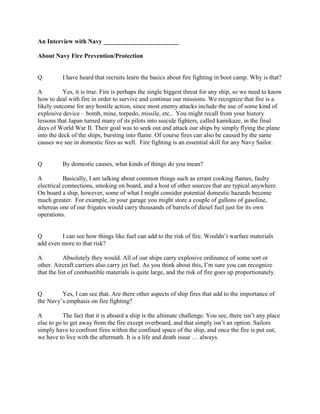
Fire control
- 1. An Interview with Navy ________________________ About Navy Fire Prevention/Protection Q I have heard that recruits learn the basics about fire fighting in boot camp. Why is that? A Yes, it is true. Fire is perhaps the single biggest threat for any ship, so we need to know how to deal with fire in order to survive and continue our missions. We recognize that fire is a likely outcome for any hostile action, since most enemy attacks include the use of some kind of explosive device – bomb, mine, torpedo, missile, etc.. You might recall from your history lessons that Japan turned many of its pilots into suicide fighters, called kamikaze, in the final days of World War II. Their goal was to seek out and attack our ships by simply flying the plane into the deck of the ships, bursting into flame. Of course fires can also be caused by the same causes we see in domestic fires as well. Fire fighting is an essential skill for any Navy Sailor. Q By domestic causes, what kinds of things do you mean? A Basically, I am talking about common things such as errant cooking flames, faulty electrical connections, smoking on board, and a host of other sources that are typical anywhere. On board a ship, however, some of what I might consider potential domestic hazards become much greater. For example, in your garage you might store a couple of gallons of gasoline, whereas one of our frigates would carry thousands of barrels of diesel fuel just for its own operations. Q I can see how things like fuel can add to the risk of fire. Wouldn’t warfare materials add even more to that risk? A Absolutely they would. All of our ships carry explosive ordinance of some sort or other. Aircraft carriers also carry jet fuel. As you think about this, I’m sure you can recognize that the list of combustible materials is quite large, and the risk of fire goes up proportionately. Q Yes, I can see that. Are there other aspects of ship fires that add to the importance of the Navy’s emphasis on fire fighting? A The fact that it is aboard a ship is the ultimate challenge. You see, there isn’t any place else to go to get away from the fire except overboard, and that simply isn’t an option. Sailors simply have to confront fires within the confined space of the ship, and once the fire is put out, we have to live with the aftermath. It is a life and death issue … always.
- 2. Q So every sailor learns something about fire fighting. Is there anyone who is in charge in the event of fire? A Training everyone in the basics is what the Navy does to assure that there are enough ready hands to take initial action and step to the fight, but we recognize that it is also important to have specialists in fire protection/prevention and public safety to take charge of this. That’s why we have advanced training in this specialty. You see, not all types of fires are fought the same way. Different methods are effective for putting out electrical fires vs. cooking fires vs. petroleum fires. What’s more, we count on these specialists to put in place and enforce policies, procedures and practices to prevent most of these situations from happening in the first place. These same highly trained individuals are charged with many other safety program developments aboard our ships. Q Could this kind of skill transfer to the civilian world? A Most definitely it does. Although there are many schools and other organizations that teach courses in fire control and public safety, virtually all of them have been modeled in some fashion after the Navy’s training program. And, given the fact that the Navy trains for extreme conditions, it is no surprise to find that of the people working in civilian fire and public safety occupations, many are former Navy sailors. Many former Navy people also have been tapped to manage safety programs for major corporations. Q How can interested people here find out more about the Navy’s opportunities in fire protection and public safety? A Actually, the best first step is to contact the local recruiting station to find out about any and all of the jobs that we have available. To reach us, simply contact our station by calling ______________, or stop in most afternoons at __________________________________. If you or an out of-town friend want to locate another station near them, visit www.navy.com and click on “find a recruiter” on the right side of the home page, then enter your zip code number. A call to 800-4go –Navy will do the trick as well. Additional comment: To put the Navy’s role in perspective, you need to recognize that 70 percent of the world is covered by ocean, 80 percent of the world’s population lives along coasts and 90 percent of the world’s commerce travels by water. Protecting all of that is our job, and that makes America’s Navy a global force for good. Sailors serve on land and from the sea; from ships on the water, submarines under the water, and planes and helicopters over the water – all to meet America’s threats far away so that those threats cannot harm us here. We welcome the best men and women to join us in accomplishing today’s missions and meeting tomorrow’s challenges.
- 3. - 30 –
